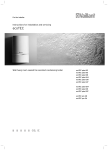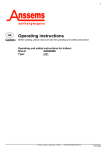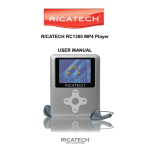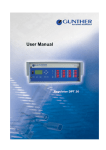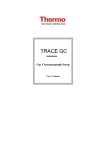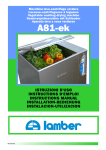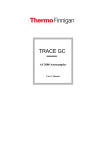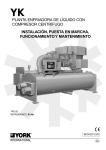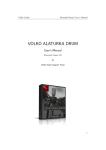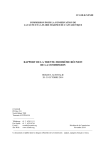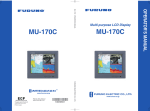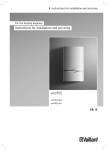Download Valco electronic Valve Oven User's Manual
Transcript
HOME Va l ve Ov en Operating Manual Valve Oven Operating Manual May 2003 Edition Part Number 317 093 63 © 2003 Thermo Finnigan Italia S.p.A. All rights reserved. Printed in Italy Published by ThermoFinnigan Italia S.p.A., Strada Rivoltana, 20090 Rodano - Milan - Italy Tel: +39 02 95059355 Fax: +39 02 95059388 Printing History: First Edition, released May 1999. Second Edition, released July 2002 Third Edition, released May 2003 Disclaimer Technical Information contained in this publication is for reference purposes only and is subject to change without notice. Every effort has been made to supply complete and accurate information; however, Thermo Finnigan assumes no responsibility and will not be liable for any errors, omissions, damage, or loss that might result from any use of this manual or the information contained therein (even if this information is properly followed and problems still arise). This publication is not part of the Agreement of Sale between Thermo Finnigan and the purchaser of a TRACE™ GC Ultra system. In the event of any conflict between the provisions of this document and those contained in Thermo Finnigans’s Terms and Conditions, the provisions of the Terms and Conditions shall govern. Reference to System Configurations and Specifications supercede all previous information and are subject to change without notice. Trademarks TRACE™ is a trademark of Thermo Finnigan Italia S.p.A.. Other brand and product names may be trademarks or registered trademarks of their respective companies. Contents About This Manual..................................................................................................................................v Overview .................................................................................................................................... v Conventions Used in This Manual............................................................................................vi Instrument Markings and Symbols ..........................................................................................vii Using the TRACE GC Ultra Document Set..............................................................................ix Chapter 1 Valve Oven Overview......................................................................................................................... 11 Introduction .............................................................................................................................. 12 Options ........................................................................................................................ 13 Installation and Power Requirements....................................................................................... 14 Power Requirements and Voltage Selection............................................................... 15 Valve Oven Components ......................................................................................................... 16 Heated Section ............................................................................................................ 17 Unheated Section ........................................................................................................ 17 Valves.......................................................................................................................... 17 Column........................................................................................................................ 17 Chapter 2 Valve Installation................................................................................................................................ 19 Introduction .............................................................................................................................. 20 Opening the Valve Oven.......................................................................................................... 20 Installing Valves in the Heated Oven....................................................................................... 21 Installing Valves in the Unheated Compartment ..................................................................... 28 Installing Valves in the Valve Box .......................................................................................... 31 Valve Box for up to Six Valves .................................................................................. 31 Valve Box for up to Two Valves ................................................................................ 31 Configuring Valves .................................................................................................................. 32 Gas Sampling Valves .................................................................................................. 32 Switching Valves ........................................................................................................ 32 Chapter 3 Operation............................................................................................................................................ 35 Operating Valves Manually ..................................................................................................... 36 Operating Valves Automatically.............................................................................................. 38 Adding a Gas Sampling Valve Event to the Run Table.............................................. 38 Adding a Gas Switching Valve Event to the Run Table............................................. 40 Operating Manual iii Contents Chapter 4 Troubleshooting .................................................................................................................................43 Leak testing................................................................................................................. 43 Valve Switching ......................................................................................................... 44 Valve Plumbing .......................................................................................................... 45 Appendix A Customer Communication ...............................................................................................................47 How To Contact Us ................................................................................................................. 47 Europe......................................................................................................................... 47 Africa, Asia and Oceania............................................................................................ 49 North, Central and South America ............................................................................. 50 Reader Survey............................................................................................................. 51 Glossary ................................................................................................................................................ 53 Index...................................................................................................................................................... 59 iv Operating Manual About This Manual Overview This Valve Oven Operating Manual contains information for operating the Valve Oven, including Troubleshooting and ordering spare parts. This manual is organized as follows: Chapter 1, Valve Oven Overview, provides an overview to TRACE GC Ultra Valve Oven features and components. Chapter 2, Valve Installation, provides instructions for installing valves in the TRACE GC Ultra Valve Oven. Chapter 3, Operation, presents operating instructions for the TRACE GC Ultra Valve Oven. Chapter 4, Troubleshooting, has information to help you find and correct potential problems when using the TRACE GC Ultra Valve Oven. Appendix A, Customer Communication, has contact information for ThermoFinnigan offices worldwide. This appendix also contains a one-page Reader Survey. Use this survey to give us feedback on this manual and help us improve the quality of our documentation. The Glossary is an alphabetical descriptive list of terms common to this industry. This also includes abbreviations, acronyms, metric prefixes, and symbols. The Index presents an alphabetical list of key terms and topics in this guide, including cross references and the corresponding page numbers. Operating Manual v Conventions Used in This Manual The following symbols and typographical conventions are used throughout this manual. Bold Bold text indicates names of windows, menus, dialog boxes, buttons, and fields. Italic Italic indicates cross references, first references to important terms defined in the glossary, and special emphasis. Monospace Monospace, or Courier, indicates filenames and file paths, or text the user should enter with the keyboard. Monospace Bold Monospace Bold indicates messages or prompts displayed on the computer screen or on a digital display. » This symbol illustrates menu paths to select, such as File»Open…. KEY NAME Bold, uppercase sans serif font indicates the name of a key on a keyboard or keypad, such as ENTER. CAUTION This symbol alerts you to an action or procedure that, if performed improperly, could damage the instrument. NOTE This symbol alerts you to important information related to the text in the previous paragraph. This symbol alerts you to an action or procedure that, if WARNING! performed improperly, could result in damage to the instrument or possible physical harm to the user. This symbol may be followed by icons indicating special precautions that should be taken to avoid injury. vi Operating Manual Instrument Markings and Symbols The following table explains the symbols used on Thermo Finnigan instruments. Not all of them are used on the TRACE GC Ultra gas chromatograph and Valve Oven. Symbol Description Direct Current Alternating Current Both direct and alternating current Three-phase alternating current 3 Earth (ground) terminal Protective conductor terminal Frame or chassis terminal Equipotentiality On (Supply) Off (Supply) Operating Manual vii Symbol Description Equipment protected throughout by DOUBLE INSULATION or REINFORCED INSULATION (Equivalent to Class II of IEC 536) Instruction manual symbol affixed to product. Indicates that the user must refer to the manual for specific Warning or Caution information to avoid personal injury or damage to the product. Caution, risk of electric shock Caution, hot surface Caution (refer to accompanying documents) In-position of a bistable push control Out-position of a bistable push control viii Operating Manual Using the TRACE GC Ultra Document Set The TRACE GC Ultra Document Set (CD-Rom PN 317 095 00) includes all manuals in electronic format, and serves as your library for information about the TRACE hardware and software. The TRACE GC Ultra Document Set (PN 317 093 00) as paper copy is also available Furthermore, ThermoFinnigan part numbers (PN) for the paper copy manuals are provided for each book title. Site Preparation and Installation Manual (PN 317 091 90) This manual and diskette describes how to set up a workspace for the TRACE GC and how to connect the TRACE GC Ultra to the gas supplies and peripheral devices. Acceptance Package (PN 317 092 20) This folder contains required shipping documents and quality report forms. Getting Started (PN 317 092 30) This guide contains sequences for checking configuration, installing detectors, and making a first analysis with the TRACE GC Ultra. Operating Manual (PN 317 091 70) This manual provides descriptions of the TRACE GC Ultra hardware and software and instructions for their use. UFM Ultra Fast Module Device (PN 317 093 98) This manual provides descriptions of the TRACE GC Ultra equipped with the UFM device. and instructions for it use. Quick Reference Card (PN 317092 40) This reference card contains guidelines for carrier gas use and injection sequences. K-Factor Quick Reference (P/N 317 092 41) This reference card contains information to interpretate results from a Column Evaluation. Operating Manual ix Preventive Maintenance Schedule (PN 317 092 80) This document provides a list of recommended scheduled maintenance and a year-long log book to record maintenance, observations, supply lists, and service records. Maintenance and Troubleshooting Guide (PN 317 091 80) This manual contains instructions for diagnosing and resolving operational problems. Standard Operating Procedures (PN 317 092 00) This manual contains instructions, operating sequences, and test criteria for final testing of the TRACE GC Ultra. Spare Parts Catalog (PN 317 092 10) This catalog contains a list of spare parts for the TRACE GC Ultra. x Operating Manual Valve Oven Overview 1 This chapter provides an overview to TRACE GC Ultra Valve Oven features and components. Chapter at a Glance... Introduction ..........................................................................................................12 Installation and Power Requirements...................................................................14 Valve Oven Components ......................................................................................16 Operating Manual 11 Chapter 1 Valve Oven Overview Introduction Introduction The TRACE GC Ultra Valve Oven, shown in Figure 1-1, is a temperature controlled enclosure for mounting up to six (four heated + two unheated) sampling and/or switching valves, 1/8" OD packed columns and up to eight needle valves and four pressure regulators. A large number of applications require this additional space for a correct analysis setup. HEATED SAMPLE TRANSFER LINE HEATED SAMPLE TRANSFER LINE D H L E I M F J N G K O WARNING USE ONLY THE ORIGINAL POWER SUPPLY FOR THIS INSTRUMENTS POWER Front View AIR 800 kPa/120 psi Max Rear View Figure 1-1. The Valve Oven 12 Operating Manual Introduction Chapter 1 Valve Oven Overview Options The type of valve enclosure can be selected among three different options depending on the analytical requirements. 1. TRACE GC Ultra Valve Oven It provides an additional isothermal heated zone to accomodate valves and columns. It consists of an inner heated enclosure and an external unheated area. The former is designed to house up to four heated valves, restrictors and 1/8” OD packed columns. The latter houses up to two valves and pressure regulators. This option is therefore particularly suitable for applications such as natural gas or refinery gas analyses where, together with the GC column oven, an additional isothermally heated area is required for gas sampling, column switching, storing or sample cutting valves. It can accommodate up to four constant pressure regulators, up to eight needle valves, plus front and rear sample and carrier gas inlets/outlets. 2. TRACE GC Ultra Valve Box for Up to Six Valves This version is the same as previous option (TRACE GC Ultra Valve Oven) but without heating elements. It provides an additional cold zone to accommodate up to four gas sampling/switching valves, up to two valves for liquid sampling, restrictors and 1/8” OD packed columns. It is therefore particularly suitable for engineered applications that can be exploited at ambient temperature, for which multi-column and/or multi-valve configurations (sampling, switching, storing or heart-cutting) are required. It can also accomodate up to four constant pressure regulators, up to eight needle valves, plus front and rear sample and carrier gas inlets/outlets 3. TRACE GC Ultra Valve Box for Up to Two Valves This version is the same as previous option (TRACE GC Ultra Valve Box for Up to Six Valves) but can accomodate ONLY up to two valves, thus providing a customized solution for not highly demanding engineered applications. This version does not include any electronics; the drivers for the two three-wayvalves controlling the pneumatic actuators are installed on the TRACE GC Ultra. It is able to accept restrictors and 1/8“ OD packed columns; it can also accommodate up to four constant pressure regulators, up to eight needle valves, plus front and rear sample and carrier gas inlets/outlets. Operating Manual 13 Chapter 1 Valve Oven Overview Installation and Power Requirements When up to two Valco Purged valves are required (e.g. applications with Pulsed Discharge Detector), this option has to be selected for their housing. For more informations, refer to Valve Oven Components. NOTE When any Valve box (heated or unheated) is configured with valves, these are factory tested to verify actuation but are NOT plumbed. Plumbing can be performed upon availability of plumbing diagrams. Materials needed: Shop air or bottled air at a pressure of 60–80 psi Helium, Nitrogen, or other gas depending on your applications Installation and Power Requirements The Valve Oven is attached to TRACE GC Ultra and it is factory installed and configured. On-site installation is related to the gas plumbing defined by the customer’s application or accompanying diagram. Figure 1-2. The Valve Oven and the TRACE GC Ultra 14 Operating Manual Installation and Power Requirements Chapter 1 Valve Oven Overview Power Requirements and Voltage Selection Valve ovens installed by the factory will contain the line voltage selected as noted by the sales order, 115 V ac or 230 V ac. The line voltage selection can be changed by relocating a jumper located behind the valve driver electronics (Figure 1-3). CAUTION AC line voltage is applied to the valve oven when the main GC is turned on. Turn the main GC power off before removing the valve oven heaters. Valve oven power for the 24 V dc solenoid is supplied by an external power module that plugs into the rear of the valve oven. This power module will accept input voltage from 106 V ac to 240 V ac. A green light on the front of the valve oven (Power On Indicator) indicates when the power module is plugged in (Figure 1-2). NOTE Operating Manual In case of using the TRACE GC Ultra Valve Box for up two valves, any power supply is necessary since the solenoid valves are activated directly by the TRACE GC Ultra. 15 Chapter 1 Valve Oven Overview Valve Oven Components Valve Oven Components The TRACE GC Ultra Valve Oven consists of four major components as shown in Figure 1-3. • Headed Enclosure • Unheated Enclosure • Valve • Column 5 1 4 3 2 1. Heated Enclosure 4. Valve Driver Electronics 2. Unheated Enclosure 5. Columns 3. Valves Figure 1-3. TRACE GC Ultra Valve Oven Components 16 Operating Manual Chapter 1 Valve Oven Overview Valve Oven Components Heated Section The heated enclosure is a temperature controlled (40 to 175 °C) isothermally heated zone, able to contain the following: • up to four (4) valves with associated sample loops • up to fifty feet of 1/8” OD stainless steel column with associated clamp and fixed unions • up to eight (8) heated needle valves (restrictors) accessible from the front • provisions for sample transfer directly into the heated zone from the front or rear of the unit Unheated Section Unheated enclosures can contain the following: • two unheated pneumatic Valco liquid or gas sample injection valves • up to four pressure regulators installed on the front of the unit, and one mounted internally • up to six in and out connections for sample loading/vent/flow measurement Valves Your TRACE GC Ultra Valve Oven has the following available valves: • standard pneumatic Valco rotary valves • standard pneumatic Valco rotary valves with purged housing Column Although the type of column you use will vary depending on your application, the TRACE GC Ultra Valve Oven typically uses packed columns. The column mounting area can accommodate 1/8” OD columns. Operating Manual 17 Chapter 1 Valve Oven Overview 18 Valve Oven Components Operating Manual Valve Installation 2 This chapter provides instructions for installing and configuring valves in the TRACE GC Ultra Valve Oven. Chapter at a Glance Introduction ..........................................................................................................20 Opening the Valve Oven.......................................................................................20 Installing Valves in the Heated Oven ...................................................................21 Installing Valves in the Unheated Compartment ..................................................28 Installing Valves in the Valve Box........................................................................31 Configuring Valves...............................................................................................32 Operating Manual 19 Chapter 2 Valve Installation Introduction Introduction NOTE Before starting, cool the Valve Oven to 50°C or cooler. Do not turn the GC off. The heated section of the Valve Oven accepts standard Valco gas actuated valves with 3-inch standoff. The unheated section will accommodate Valco gas actuated valves without standoff. CAUTION Be careful not to mix actuators with valves that have different numbers of ports, as the actuator travel for each valve can be different. Opening the Valve Oven WARNING! The Valve Oven cover can be very hot. Use caution when removing the heated Valve Oven cover. 1. Remove the top cover by releasing a single screw on the Valve Oven compartment rear panel. 2. Slide the panel toward the rear about ½ inch and lift away. This exposes the heated Valve Oven cover and valve pneumatics. 3. To remove the heated Valve Oven cover, locate the two thumb screws on the lower edge of the heated Valve Oven cover. 4. Turn these screws counter clockwise (ccw) to release the cover. The cover can be removed by lifting up and pulling out. 20 Operating Manual Installing Valves in the Heated Oven Chapter 2 Valve Installation Installing Valves in the Heated Oven Installing valves consists of the following steps: Step 1. Installing the solenoid Step 2. Disassembling the valve and actuator Step 3. Installing the valve and standoff Step 4. Connecting gas lines from the solenoid to the actuator Step 5. Installing the actuator to the valve standoff Step 6. Testing the valve CAUTION Turn the actuator gas off before you start these procedures. Step 1. Installing the Solenoid Valves 1. Locate the solenoid manifold in the rear floor of the valve compartment (Figure 2-1). The space closest to the rear of the GC is reserved for pneumatic valve 1, next is valve two, and so on. A total of 6 pneumatic valves can be installed (up to 4 in the upper compartment and up to 2 in the lower). 2. Remove the rectangular shaped cap from the manifold using the #0 phillips screwdriver. 3. Secure the solenoid valve to the underplate using the two screws supplied with the valve. CAUTION Operating Manual Tighten screws evenly, taking care that the solenoid gasket rests on all surfaces to prevent leaks 21 Chapter 2 Valve Installation Installing Valves in the Heated Oven 1 2 3 4 1. Time Event Output Jack 2. Solenoid Manifold 3. Valve 1 Position 4. Valve 2 Position Figure 2-1. Timed Event Output Jacks, Solenoid Manifold, and Valve Positions 4. Connect the cable from the solenoid valve (Figure 2-4) to the proper timed event output jack (Figure 2-2) located in the lower rear inside corner of the valve compartment. Valve 1 is attached to timed event #8 (TE8), Valve 2 is attached to timed event #7 (TE7), and so forth (Figure 2-2). 22 Operating Manual Chapter 2 Valve Installation Installing Valves in the Heated Oven TE #1 TE #2 TE #3 TE #4 TE #5 TE #6 TE #7 TE #8 Sensor Figure 2-2. Timed Event (TE) Output Jacks Step 2. Disassembling the Valve and Actuator NOTE Valves are usually installed starting from the mounting hole closest to the rear of the Valve Oven. 1. Remove any insulation found in the valve mounting hole. The valve mounting hole is located in the lower Valve Oven heater block. 2. Inspect the valve and actuator being sure the valve is in the counter clock wise (ccw) position. The ccw position is when the mechanical stop is in the position noted in Figure 2-3. If the valve is not in the ccw position, locate the square nut on the opposite end of the actuator (Figure 2-5). Operating Manual 23 Chapter 2 Valve Installation Installing Valves in the Heated Oven yyyyy @@ ;; @@@ ;;; @@yyy ;; yy @@@ ;;; Clockwise (CW) Position Counterclockwise (CCW) Position Mechanical stop Figure 2-3. Mechanical Stop Positions for both CW and CCW 3. Using a 5/16” or 8mm wrench, rotate the nut to the ccw position (Figure 2-5). 4. Once the valve is in the ccw position, separate the actuator from the valve and standoff by loosening the allen screw in collar B (Figure 2-5). CAUTION Be careful to pull the actuator away from the valve standoff by gripping the standoff but without rotating the actuator or the valve. NOTE Handle the valve and standoff with care so the two pieces do not separate. 5. Remove the collar attached to the valve standoff (collar A, Figure 2-5) by loosening the screw that secures the collar to the valve standoff. This collar mounts to the Valve Oven heater block. Step 3. Installing the Valve and Standoff 1. Locate the desired valve position in the heater block and place the collar over the hole in the heater block. 2. Secure the collar using two M 4 x10 mm screws. Be sure the 7/64” set screw in the collar is accessible from the outer edge of the Valve Oven. 24 Operating Manual Chapter 2 Valve Installation Installing Valves in the Heated Oven 3. Grip the valve standoff by the standoff only, and slide it through the collar allowing it to extend into the lower valve compartment. Step 4. Connecting Gas Lines from the Solenoid Valve o the Actuator NOTE Gas lines are much easier to connect to the actuator if the connection is made before the actuator is assembled to the valve. 1. Locate the 1/8 in. nylon tubing supplied in the Valve Oven kit and cut it into two equal 12” pieces. 2. Push one of the tube pieces into the lower fitting on the actuator assembly, making sure it passes through the ferrule in the actuator fitting. Tighten the nut and ferrule using a 3/8” open end wrench. Use a backup 3/8” open end wrench on the mating piece that is screwed into the actuator. 3. Place the other end of the tubing into the valve solenoid fitting located on the outside edge (Figure 2-4) of the solenoid by pushing the tubing firmly into the fitting. It should automatically seal in place. 1 2 1. Inside Edge Solenoids 2. Outside Edge Solenoids Figure 2-4. Solenoid Manifold Edges 4. Turn the actuator gas supply on. This line should now be pressurized. Operating Manual 25 Chapter 2 Valve Installation Installing Valves in the Heated Oven 5. Verify there are no major leaks in the fittings. NOTE Applying pressure to this side of the actuator will ensure that the actuator stays in the ccw position. 6. Take the other 1/8” piece of nylon tubing and place it in the upper fitting on the actuator. Be sure the tube passes through the ferrule in the fitting. Tighten the fitting using the 3/8” open end backup wrench. 7. Connect the opposite end to the solenoid fitting. NOTE The tubing can be released from the solenoid by pushing down on the solenoid fitting and pulling out on the tubing at the same time. Step 5. Installing the Actuator to the Valve Standoff 1. Carefully fit the actuator into the valve standoff being sure not to rotate the valve. 2. Once the two square fittings on the actuator and valve are coupled, tighten the collar on the valve. Be sure this fitting is very tight so the actuator will not rotate on the valve standoff. 3. Slide the valve and actuator assembly up or down to the desired location and tighten the upper collar to hold the valve and actuator in place. 26 Operating Manual Chapter 2 Valve Installation Installing Valves in the Heated Oven 1. Valve 1 2. Mechanical Stop Valve 3. Valve Standorf 2 3 4. M4 x 10 mm Screws 5 4 5. Collar “A” 6. Collar Set Screws 6 7 7. Heater Plate 8. Collar “B” 8 9. Actuator 10 Square Nut 9 10 Figure 2-5. Installing the actuator to the valve standoff Step 6. Testing the Valve 1. Configure the valve and rotate it clockwise and counter-clockwise. Refer to Chapter 3, Operation for more information. 2. Ensure that the valve moves freely in both directions. 3. Refer to Figure 2-3 and inspect the valve stop when the valve is in both positions to ensure that the stop is at the travel limit on each side. Operating Manual 27 Chapter 2 Valve Installation Installing Valves in the Unheated Compartment Installing Valves in the Unheated Compartment Unheated valves are installed in the area below the Valve Oven. Unheated valves do not use a standoff. Valves and actuator assemblies are installed without removing the actuator from the valve. Installing valves in the unheated compartment consists of the following steps: Step 1. Installing the Mounting Bracket Step 2. Connecting gas lines from the solenoid to the actuator Step 3. Installing the valve and bracket CAUTION Turn the actuator gas off before you start these procedures. Step 1. Installing the Mounting Bracket Each unheated valve assembly will require a mounting bracket, included as part of the liquid valve assembly. 1. Install the bracket to the lower portion of the actuator using two M4 x 10 screws (Figure 2-6). 2. Choose two mounting holes in the bracket that will allow the actuator and the valve to be oriented in a favorable direction. Step 2. Connecting Gas Lines from the Solenoid to the Actuator NOTE Gas lines are much easier to connect to the actuator if the connection is made before the valve/actuator and bracket are secured to the floor of the valve enclosure. 1. Locate the 1/8” nylon tubing supplied in the Valve Oven kit and cut it into two equal 12” pieces. 2. Push one of the tube pieces into the lower fitting on the actuator assembly, making sure it passes through the ferrule in the actuator fitting. Tighten the nut and ferrule using a 3/8” open end wrench. Use a backup 3/8” open end wrench on the mating piece that is screwed into the actuator. 28 Operating Manual Installing Valves in the Unheated Compartment Chapter 2 Valve Installation 3. Place the other end of the tubing into the valve solenoid fitting located on the outside edge of the solenoid by pushing the tubing firmly into the fitting. It should automatically seal in place. 4. Turn the actuator gas supply on. This line should now be pressurized. 5. Verify there are no noticeable leaks in the fittings. NOTE Applying pressure to this side of the actuator will ensure that the valve and actuator rotates to the ccw position. 6. Take the other 1/8 in piece of nylon tubing and place it in the upper fitting on the actuator. Be sure the tube passes through the ferrule in the fitting. Tighten using the 3/8” open end wrench with backup. 7. Connect the opposite end to the inside fitting on the solenoid. Step 3. Installing the Valve Bracket Once the gas lines are attached to the actuator and the valves, the actuator and bracket are ready to be mounted inside the valve compartment. 1. Locate the three sets of mounting holes in the Valve Oven compartment floor. 2. Select the desired set of holes and secure the valve bracket to the holes using M 4 x 10 screws (Figure 2-6). NOTE Operating Manual Liquid sample valves should be mounted such that the C and P ports are next to the feedthroughs in the Valve Oven. 29 Chapter 2 Valve Installation Installing Valves in the Unheated Compartment 1 2 3 4 1. Valve 2. Valve Mechanical Stop 3. Collar “A” 4. Actuator Figure 2-6. Installing an Unheated Compartment Valve 30 Operating Manual Chapter 2 Valve Installation Installing Valves in the Valve Box Installing Valves in the Valve Box This version of Valve Oven is used when any valves heating is required. Valve Box for up to Six Valves This option is analogous to the Valve Oven but without heating elements. Hence, for the valves installation procedure, follows all the steps described previously for the heated oven and unheated compartment. Refer to: • Installing Valves in the Heated Oven • Installing Valves in the Unheated Compartment Valve Box for up to Two Valves This option does not contain any heating elements. Besides, it is designed to accomodate only up to two valves.It does not include any electronics and the solenoid valves controlling the valves actuators are droven by the TRACE GC Ultra. The solenoid valves are connected to the timed event output located on the Mother Board of the TRACE GC Ultra. — Sampling Valve 1 must be connected to J51 — Sampling Valve 2 must be connected to J52 Then, the valves installation follows the same procedure described previously for the heated oven and unheated compartment. Refer to: Operating Manual • Installing Valves in the Heated Oven • Installing Valves in the Unheated Compartment 31 Chapter 2 Valve Installation Configuring Valves Configuring Valves The valves in the Valve Oven are gas-actuated. The valves are controlled by solenoid valves that are turned on and off by timed events. Each solenoid valve uses one timed event. Valve 1 will use timed event # 8, Valve 2 will use timed event # 7, and so on. Once a valve occupies a timed event, this timed event is removed from the list of external events that can be added to a run table. You can configure a valve to be a gas sampling valve or a switching valve. Gas Sampling Valves Gas sampling valves have two positions—Load and Inject. These correspond to the OFF and ON positions, respectively. Gas sampling valves are plumbed so that counter-clockwise position is Load and the clockwise position is Inject yyyyy @@ ;; @@@ ;;; @@yyy ;; yy @@@ ;;; Load (OFF) Position Inject (ON) Position Mechanical stop Figure 2-7. Mechanical Stop Positions for Gas Valves Switching Valves Switching valves have two positions—On and Off. Switching valves are plumbed so that the counter-clockwise position is Off and the clockwise position is On. NOTE Typically, the valve nearest to the rear of the Valve Oven will be configured as valve 1. 1. Press CONFIG on the TRACE GC Ultra keypad. 32 Operating Manual Chapter 2 Valve Installation Configuring Valves 2. Scroll to Valves and press ENTER. 3. Select Valve #1 and press ENTER. • If you want valve #1 to be a gas sampling valve, select Gas sampling. • If you want valve #1 to be a switching valve, select Switching. 4. Press ENTER. 5. Press CLEAR to return to the Configure Valves menu. 6. Repeat as necessary for the remaining valves in the Valve Oven or valve compartment. yyyyy @@ ;; @@@ ;;; @@yyy ;; yy @@@ ;;; Clockwise (CW) Position Counterclockwise (CCW) Position Mechanical stop Figure 2-8. Mechanical Stop Positions for Switching Valves Operating Manual 33 Chapter 2 Valve Installation 34 Configuring Valves Operating Manual Operation 3 This chapter presents operating instructions for the TRACE GC Ultra Valve Oven. The valves can be operated manually using the keypad on the TRACE GC Ultra, or automatically using the run table accessed on the TRACE GC Ultra keypad. Chapter at a Glance... Operating Valves Manually ..................................................................................36 Operating Valves Automatically...........................................................................38 Operating Manual 35 Chapter 3 Operation Operating Valves Manually Operating Valves Manually 1. Press VALVES on the TRACE GC Ultra keypad. Valves Key Figure 3-1. The TRACE GC Ultra Keypad, Showing the Valves Key 2. Scroll to the valve you want to operate. The display may look like this: VALVES Inlet Valves #1 Gas Sample #2 Switching • 36 Load < Off If the valve is a gas sampling valve, press On to place the valve in the Inject position or Off to place the valve in the Load position. Operating Manual Chapter 3 Operation Operating Valves Manually • If the valve is a switching valve, press On to place the valve in the clockwise (CW) position or Off to place the valve in counterclockwise (CCW) position. The display changes to reflect the current valve state. • The default conditions of a switching valve determines which position (ON or OFF) the valve is in after GC initialization and after a run is completed. The default conditions can be changed by selecting Switch vlv defaults from the VALVES menu. VALVES #2 Switching #3 Gas Sample Switch vlv defaults • Operating Manual Off Load Off< Scroll to the switching valve you wish to change and press On or Off to enter its new default condition. 37 Chapter 3 Operation Operating Valves Automatically Operating Valves Automatically Press the RUN TABLE key to access the TRACE GC Ultra Run Table display. You can automatically switch valves by adding the desired valve event to the run table. Run Table Key Figure 3-2. The TRACE GC Ultra Keypad, Showing the Run Table Key Adding a Gas Sampling Valve Event to the Run Table 1. On the TRACE GC Ultra keypad, press RUN TABLE. RUN TIME EVENTS <None> Add run time event < Ext. event defaults 38 Operating Manual Chapter 3 Operation Operating Valves Automatically 2. Scroll to Add Run Time Event and press ENTER. SELECT EVENT to add Signal Valve < External Event 3. Select Valve and press ENTER. 4. Scroll to the sampling valve that you want to add and press ENTER. SELECT PARAM to Add Valve #1 Sampling Valve #2 Switching Valve #3 Sampling < The following screen appears: RUN TIME EVENT Valve #1 Sampling Inject at 0.00 Inject for 0.00 The Inject at parameter is the time into the run that the sample is to be injected. The Inject for parameter is the time that the valve remains into the inject position. After that time, the valve returns to the Load position. If the Inject for time exceeds the GC run time, the GC will automatically reset the valve to the Load position at the end of the run. 5. Repeat as necessary for any remaining sampling valves. If you need to edit a run table entry, select the entry to be edited and press ENTER. NOTE Operating Manual To delete a run table entry, select it and press CLEAR. The TRACE GC Ultra will ask you if you really want to delete the entry. Press YES. 39 Chapter 3 Operation Operating Valves Automatically 6. Press CLEAR three times to exit to the Run Event table. NOTE Pressing CLEAR within a run table entry will delete that entry. To use CLEAR to back out of the menu, you must first be out of the run table entries themselves. Adding a Gas Switching Valve Event to the Run Table For switching valves, two run time entries are required—one to switch the valves on and one to switch the valves off. 1. On the TRACE GC Ultra keypad, press RUN TABLE. 2. Scroll to Add run time event and press ENTER. 3. Select Valve and press ENTER. SELECT PARAM to Add Valve #1 Sampling Valve #2 Switching Valve #3 Sampling < 4. Scroll to the Switching valve that you want to add and press ENTER. RUN TIME EVENT Valve #2 Switching Run time 0.00 Setpoint On (Off) The Run time parameter is the time into the run when the valve switches to the new position. The Setpoint parameter is the position that the valve will go to at the selected time. The On value usually designates a clockwise switch and the Off value designates a counterclockwise switch. If you want the valve to switch back to its original position at the end of run, then do not need enter a second run table entry. 40 Operating Manual Chapter 3 Operation Operating Valves Automatically If you want the valve to switch back before the end of run, press CLEAR to return to the SELECT PARAM to add menu and select the same valve again. Press ENTER. Type the desired switching time and press ENTER. Select the position the valve is to return to by selecting ON or OFF and press ENTER. With no run table entries selected, press CLEAR multiple times to exit to the run event table. OPERATING PROCEDURE Heating the Valve Oven 1. On the TRACE GC Ultra keypad, press AUX. 2. Scroll to Temperature Zones and press ENTER. AUXILIARY ZONE Valve oven 43 current value 175 target value 3. Enter the target temperature and press ENTER. NOTE Operating Manual Press INFO to determine temperature limits. 41 Chapter 3 Operation 42 Operating Valves Automatically Operating Manual Troubleshooting 4 This chapter has information to help you to find and correct potential problems when using the TRACE GC Ultra Valve Oven. Chapter at a Glance… Leak Testing .........................................................................................................43 Valve Switching....................................................................................................44 Valve Plumbing ....................................................................................................45 The most common problem associated with valves and plumbing are leaks, valves not switching properly, and valves not plumbed correctly. Leak testing Leak testing requires studying plumbing diagrams and system configurations. 1. Identify all gas sources leading into the flow path to be leak tested. Determine if the gas sources are either a common source or if they are at the same bottle pressure. 2. Be sure all components in the sample path will withstand the pressure being applied to the system. 3. Be sure all possible gas outlets are blocked. This will require knowing how to identify the various flow paths throughout the valving system to be sure vents are blocked or bypassed. NOTE Operating Manual Leak should be detected using an electronic leak detector. 43 Chapter 4 Troubleshooting Refer to the TRACE operations manual, Chapter 4, Gases and Controls, for leak test suggestions and the necessary hardware required to pressure check a plumbing system. Table 4-1. Leak Testing for Valves Symptom Cause Remedy Valve leaking between ports Defective rotor Replace rotor or valve Valve leaking around rotor Valve rotor not seating properly Tighten rotor Rotor Defective Replace Rotor in valve Ferrule not seating Replace ferrule Leaking out valve ports Valve Switching Valco valves contain a rotor that is turned by the actuator. This rotor channels the gas between the various ports of the valve. If the rotor is not being switched properly, a flow path may be partially or fully blocked, or leaks may occur between valve ports. Each valve contains a mechanical stop that should reach an extreme when the valve is rotated in the clockwise or counterclockwise direction. Close inspection of the valve will indicate if the valve is being switched to its limits, Figure 2-4. Actuator pressure should be 420 Kpa (60psig) to 630 Kpa (90 psig). Table 4-2. Causes and Remedies for Improper Valve Switching Cause Remedy Low actuator line pressure Increase line pressure Solenoid not actuating Verify timed event is set correctly Check voltage at solenoid Replace defective solenoid 44 Operating Manual Chapter 4 Troubleshooting Table 4-2. Causes and Remedies for Improper Valve Switching Cause Remedy Actuator leaking Replace actuator Valve event not set correctly Check valve event configuration and event in the run table Valve Plumbing Verify the valve and system plumbing conforms to the appropriate plumbing diagram for your system setup (See Chapter 3). Trace the plumbing from port to port to insure all connections are made properly Operating Manual 45 Chapter 4 Troubleshooting 46 Operating Manual A Customer Communication This appendix has contact information for Thermo Finnigan offices worldwide. This appendix also contains a one-page Reader Survey. Use this survey to give us feedback on this manual and help us improve the quality of our documentation. How To Contact Us ThermoFinnigan provides comprehensive technical assistance worldwide and is dedicated to the quality of our customer relationships and services. Use this list to contact your local Thermo Finnigan office or affiliate. Europe AUSTRIA BELGIUM Thermo Finnigan Austria wissenschaftliche Geräte GmbH Wehlistrasse 27 b, A-1200, Wien Tel: 1 33350340 Fax:: 1 333503426 Also serving BULGARIA, CROATIA, CZECH REPUBLIC, HUNGARY, POLAND, RUMANIA SLOVAKIA, SLOVENIA Interscience SPRL Scientific Parc Einstein –Avenue Jean-Etienne Lenoir 2 B-1348 Louvain-la-Neuve Tel: 010 450025 Fax:010 453080 CIS and formerly USSR Republics DENMARK Neolab Moskow Office 1 Y Obidenskiy Per. B. 10 - Office 2 119034 Moscow Tel: ++ 7 (095) 9264148/70/71 Fax:: ++ 7 (095) 9264514 ThermoFinnigan AB - Sweden Pyramidbacken 3 SE 14175 Kugens Kurva Tel: (8) 55646800 Fax: (8) 55646808 Operating Manual 47 Customer Communication How To Contact Us FINLAND FRANCE Oy G.W. Berg & Co. AB PO Box 12 Finn 02201 Espoo Tel: (9) 88664600 Fax: (9) 88664699 ThermoFinnigan France SA Hightec Sud 12 Avenue des Tropiques – Z.A. de Courtaboeuf BP 141 - 91944 Les Ulis Cedex Tel: (01) 6918 8810 Fax:: (01) 6929 9382 GERMANY GREECE Thermo Finnigan APG Gmbh Boschring 12, 63329 Egelsbach Tel: (06103) 4080 Fax: (06103) 408 222 Rigas Labs 5, Salaminos Str. 546 26 Thessaloniki - Greece Tel: (031) 550669/540410 Fax: (031) 550073 IRELAND ITALY ThermoFinnigan U.K. 19 Trentham Lake South Imex Technology Park, Trentham ST4 8JF, Stoke on Trent, STAFF Tel: (1782) 645136 Fax: (1782) 645121 Thermo Finnigan Italia S.p.A. Strada Rivoltana 20090 Rodano (Milan) Tel: (02) 95059226 Fax: (02) 95059256 NETHERLANDS NORWAY Interscience B.V. Tinstraat 16, Postbus 2148, 4800 CC Breda Tel: (076) 5411800 Fax: (076) 5420088 IT Instrument Teknikk Skandinavia A/S – PO Box 14 Grins Naeringspark 1 N-1345 Østerås Tel: (67) 149303 Fax: (67) 149302 PORTUGAL SPAIN Unicam Sistemas Analiticos, Lda. Estrada da Rocha, 2-A-Sala C 2799-508 Linda A Velha Tel: (21) 4153740 Fax: (21) 414 2006 Thermo Finnigan – Thermo Instruments S.A. Avenida Valdelaparra 27 Edifico Alcor – 2a Planta 28108 Alcobendas – Madrid Tel: (91) 6574930 Fax: (91) 6574937 SWEDEN SWITZERLAND ThermoFinnigan AB - Sweden Pyramidbacken 3 SE 14175 Kugens Kurva Tel: (8) 55646800 Fax: (8) 55646808 Brechbühler AG Steinviesenstrasse 3, CH 8952 Schlieren Tel: (01) 732 3131 Fax: (01) 730 6141 48 Operating Manual How To Contact Us Customer Communication TURKEY UNITED KINGDOM Dolunay Teknik Cihazlar Ltd. Darulaceze Cad. No 43/A 80290 Okmeydani Istanbul Tel: (212) 2105435 Fax: (212) 2105434 Thermo Finnigan U.K. 19 Trentham Lake South Imex Technology Park, Trentham ST4 8JF, Stoke on Trent, STAFF Tel: (1782) 645136 Fax: (1782) 645121 Africa, Asia and Oceania AUSTRALIA EGYPT Thermo Finnigan Australia PTY LTD Unit 14, 38-46 South Street Rydalmere, NSW 2116 Tel: 02 9898 9000 Fax:: 02 9898 9800 Scientic Services 20, Shehab Street, El Mohandeseen Dokki, Cairo Tel: (2) 3600482 Fax:: (2) 3481424 INDIA ISRAEL Nulab Equipment Co. Pvt. Ltd. Labhouse Plot No. F-13 Opp. Seepz, Marol M.I.D.C. Andheri (East) Mumbay 400 093 Tel: (022) 8376701 Fax:: (022) 8368275 Burgal Analytical Instruments & Software Ltd. 4 Wallenberg Raoul Street Tel Aviv 69719 Tel: (3) 6490823 Fax: (03) 6490826 JAPAN JORDAN Thermo Finnigan K.K. Nishi-Shinjuku, Toyokuni Building 2-5-8 Hatsudai, Shibuya-ku, Tokyo 151-0061 Tel: (03) 3372 3001 Fax: (03) 3372 7051 Hijaz Electronic & Scientific Supplies Est P.O. Box 925133 Amman 11110 Tel: (6) 5359761 Fax: (6) 5359761 KOREA InSung Chromotech Co., Ltd. LEBANON InSung Bldg 89-111, Shinjung 2-dong Yangcheon-Ku – Seoul Tel: (02) 2644 1991 Fax: (02) 2644 1996 LaboTech Engineering Ashrafieh, Monot Street, P.O. Box 16 7186 Beirut Tel: (1) 332707 Fax: (1) 333707 NEW ZEALAND PAKISTAN Alphatech Systems Ltd & Co. P.O. Box 37583 Parnell Auckland Tel: (09) 3770392 Fax: (09) 3098514 Total Technology 1st floor, 4-Singhar Centre, 16 Mc Lagan Road Lahore 54000 Tel: (42) 7236469/7224459 Fax: (42) 7234689 Operating Manual 49 Customer Communication How To Contact Us PEOPLES REPUBLIC OF CHINA SINGAPORE Finnigan Beijing Office Room 912-916, Ping-an Mansion no 23 Finance Street Xi Cheng District Beijing Tel: (10) 66210852 Fax: (10) 6610851 CE Instruments Enterprise Singapore c/o Sintech Scientific S.E.A. Pte Ltd No. 196 Pandan Loop #02-18 Pantech Industrial Complex Singapore 128384 Tel: +65 779 0007 Fax: +65 2346252 Also serving INDONESIA, MALAYSIA, THAILAND, PHILIPPINES SOUTH AFRICA TAIWAN R.O.C. Premier Technologies P.O Box 173 Northriding 2162 South Africa Tel: (011) 4661410 Fax: (011) 4661313 E Hong Instruments Co, Ltd. 2FL, No.157, Sec 2, Fu Hsing S. Road Taipei 106 Taiwan R.O.C. Tel: (02= 2755 2266 Fax: (02) 2707 7693 U.A.E BDH Middle East P.O. Box 28637 Dubai Tel: (4) 2852211 Fax: (4) 2861331 North, Central and South America CANADA U.S.A Thermo Finnigan Americas Tel: (732) 981-0390 Fax: (732) 981-0029. .Thermo Finnigan Americas Tel: (732) 981-0390 Fax: (732) 981-002 50 Operating Manual Reader Survey Product: Manual: Part No.: Valve Oven for TRACE GC Ultra Valve Oven Operating Manual 317 093 63 Please help us improve the quality of our documentation by completing and returning this survey. Circle one number for each of the statements below. Strongly Agree Agree Neutral Strongly Disagree Disagree The manual is well organized. 1 2 3 4 5 The manual is clearly written. 1 2 3 4 5 The manual contains all the information I need. 1 2 3 4 5 The instructions are easy to follow. 1 2 3 4 5 The instructions are complete. 1 2 3 4 5 The technical information is easy to understand. 1 2 3 4 5 Examples of operation are clear and useful. 1 2 3 4 5 The figures are helpful. 1 2 3 4 5 I was able to install the system using this manual. 1 2 3 4 5 If you would like to make additional comments, please do. (Attach additional sheets if necessary.) ________________________________________________________________________________________ ________________________________________________________________________________________ ________________________________________________________________________________________ Fax or mail this form to: Thermo Finnigan Italia S.p.A. Strada Rivoltana km 4 20090 Rodano (MI) ITALY Fax: 39 02 95059388 Glossary This section is an alphabetical descriptive list of terms common to this industry. This also includes abbreviations, acronyms, metric prefixes, and symbols. A A ampere ac alternating current ADC analog-to-digital converter B b bit B byte (8 b) baud rate data transmission speed in events per second C ºC Celsius CIP Carriage and Insurance Paid To cm centimeter CPU central processing unit (of a computer) CSE Customer Service Engineer D Operating Manual d depth DAC digital-to-analog converter dc direct current DS data system 53 Glossary E ECD Electron Capture Detector EMC electromagnetic compatibility ESD electrostatic discharge F ºF Fahrenheit FID Flame Ionization Detector FOB Free on Board FPD Flame Photometric Detector ft foot G g gram gain A measure of the ability of an electronic circuit or device to increase the magnitude of an electronic input parameter. GC gas chromatograph GND electrical ground H 54 h height h hour harmonic distortion A high-frequency disturbance that appears as distortion of the fundamental sine wave. HOT OC High Oven Temperature Cold On-Column Injector HV high voltage Operating Manual Glossary Hz hertz (cycles per second) I ID inside diameter IEC International Electrotechnical Commission impulse See transient in inch I/O input/output K k kilo (103 or 1024) K Kelvin kg kilogram kPa kilopascal L l length l liter LAN Local Area Network lb pound LED light-emitting diode LVOCI Large Volume On-Column Injector LVSL Large Volume Injector M Operating Manual m meter (or milli [10-3]) M mega (106) 55 Glossary µ micro (10-6) MBq megabecquerel mCi millicurie meniscus The curved upper surface of a column of liquid. min minute mL milliliter mm millimeter m/z mass-to-charge ratio N n nano (10-9) negative polarity The inverse of a detector signal polarity. nm nanometer NPD Nitrogen Phosphorous Detector O OCI On-Column Injector OD outside diameter Ω ohm P 56 p pico (10-12) Pa pascal PCB printed circuit board PDD Pulsed Discharge Detector PID Photoionization Detector Operating Manual Glossary PKD Packed Column Injector PN part number PPKD Purged Packed Column Injector psi pounds per square inch PTV Programmable Temperature Vaporizing Injector R RAM random access memory RF radio frequency ROM read-only memory RS-232 industry standard for serial communications S s second S/SL Split/Splitless Injector sag See surge slow average A gradual, long-term change in average RMS voltage level, with typical durations greater than 2 s. SOP Standard Operating Procedures source current The current needed to ignite a source, such as a detector lamp. surge A sudden change in average RMS voltage level, with typical duration between 50 µs and 2 s. T TCD Operating Manual Thermal Conductivity Detector 57 transient A brief voltage surge of up to several thousand volts, with a duration of less than 50 µs. U UFM Ultra Fast Module V V volt V ac volts, alternating current V dc volts, direct current VGA Video Graphics Array W w Width W Watt The symbol for a compound unit that is a quotient (for example, degrees Celsius per minute or grams per liter) is written with a negative exponent with the denominator. For example: °C min-1 instead of °C/min g L-1 instead of g/L Index Column 17 Components 16 Configuring Valves 32 Troubleshooting 43 Leak testing 43 Valve plumbing 45 Valve switching 44 G U C Gas Sampling Valves 32 H Heated Enclosure 17 Installing valves in 21 I Installation 14 Valves in the Heated Oven 21 Valves in the Unheated Compartment 28 Valves in the Valve Box 31 Installing 28 Installing an unheated compartment valve 30 Installing the actuator to the valve standoff 27 Unheated Enclosure 17 Installing valves 28 V Valve positions 22 Valves 17 Voltage Selection 15 M Mechanical Stop Positions 24 Mechanical Stop Positions for Switching Valves 33 O Operation 35 Adding a Gas Sampling Valve Event to the Run Table 38 Adding a Gas Switching Valve Event to the Run Table 40 Heating the Valve Oven 41 Operating valves automatically 38 Operating valves manually 36 Overview 11 P Power Requirements 15 S Solenoid Manifold 22 Switching Valves 32 T Timed Event Output Jacks 22, 23 Operating Manual 59 Index 60 Operating Manual Figure 1-1. Figure 1-2. Figure 1-3. Figure 2-1. Figure 2-2. Figure 2-3. Figure 2-4. Figure 2-5. Figure 2-6. Figure 2-7. Figure 2-8. Figure 3-1. Figure 3-2. The Valve Oven............................................................................................................12 The Valve Oven and the TRACE GC Ultra .................................................................14 TRACE GC Ultra Valve Oven Components................................................................16 Timed Event Output Jacks, Solenoid Manifold, and Valve Positions .........................22 Timed Event (TE) Output Jacks ...................................................................................23 Mechanical Stop Positions for both CW and CCW .....................................................24 Solenoid Manifold Edges .............................................................................................25 Installing the actuator to the valve standoff .................................................................27 Installing an Unheated Compartment Valve ................................................................30 Mechanical Stop Positions for Gas Valves ..................................................................32 Mechanical Stop Positions for Switching Valves ........................................................33 The TRACE GC Ultra Keypad, Showing the Valves Key...........................................36 The TRACE GC Ultra Keypad, Showing the Run Table Key .....................................38 Table 4-1. Table 4-2. Leak Testing for Valves ...............................................................................................44 Causes and Remedies for Improper Valve Switching ..................................................44































































